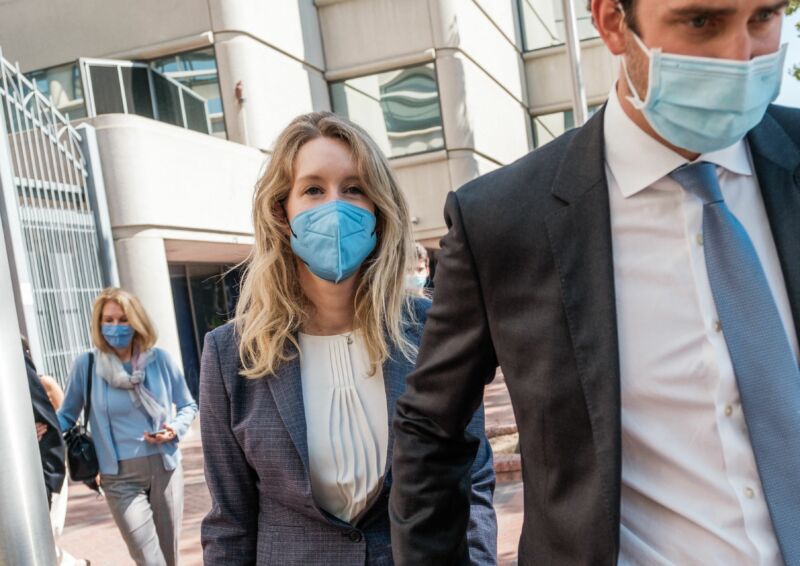

Theranos’ second lab director got $5K a month to rubber-stamp forms
source link: https://arstechnica.com/tech-policy/2021/10/theranos-hired-coos-longtime-dermatologist-as-lab-director-jury-hears/
Go to the source link to view the article. You can view the picture content, updated content and better typesetting reading experience. If the link is broken, please click the button below to view the snapshot at that time.

Theranos trials —
Theranos’ second lab director got $5K a month to rubber-stamp forms
COO Balwani hired his longtime dermatologist to run Theranos’ lab.
Tim De Chant - 10/15/2021, 1:08 PM

In yesterday’s installment of the criminal trial of Theranos founder Elizabeth Holmes, the jury heard some eye-opening testimony from Sunil Dhawan, the doctor Theranos hired to replace its previous lab director.
Dhawan was the longtime dermatologist of Theranos COO Ramesh “Sunny” Balwani, who will be facing the same fraud charges as Holmes in the spring. Dhawan was a board-certified doctor, so he met state and federal requirements to be a lab director.
But unlike Adam Rosendorff, the previous director who resigned over the questionable accuracy of the company’s test results, Dhawan was not board-certified in laboratory science, nor did he have any prior experience running a lab of that scale or scope. Dhawan also admitted that he had to google Theranos’ tech when Balwani initially approached him—before he was recruited, he didn't know much about the company’s technology.But after some googling and “one short conversation about it,” Dhawan agreed to serve as Theranos’ lab director so long as it didn’t interfere with his day job as a dermatologist or his family life. “The time commitment is very minimal,” Balwani assured him.
And it was. Dhawan testified that he went to Theranos twice and that he worked a total of five to ten hours between November 2014 and June 2015. During that time, he basically signed whatever Balwani sent him. Theranos agreed to pay him $5,000 per month, though Dhawan says he never cashed any checks and once asked to be paid in stock options instead.
State inspection
Things ramped up a bit in September 2015, when Dhawan had to go to Theranos’ headquarters to sign 300 standard operating procedures in person. “Rosendorff’s signature provided comfort to me—gave me some reassurance there had been some supervision before my arrival,” Dhawan said. Also in September 2015, Dhawan was present for a state inspection of the lab.
Before the lab inspection, Dhawan hadn’t spoken with anyone who worked in the lab. “There wasn’t one time you spoke to a Theranos employee who worked in the lab?” assistant US attorney Jeff Schenk asked him.
Advertisement“I don’t recall any conversation in that length of time,” Dhawan said. He also said he didn’t meet with any other employees, doctors, or patients. He didn’t meet Holmes until September 2015.
After the lab inspection, Dhawan said the work dwindled, and no one at Theranos told him when he was relieved from his post.
Under cross-examination by Holmes’ attorney Lance Wade, Dhawan said he assumed Balwani was “a top executive.”
“He was running the laboratory from an operational standpoint, correct?” Wade asked.
“I can’t comment on that because I was never told he was running the lab,” Dhawan said, “but it was my assumption he was, yeah.”
More details on Walgreens deal
Before Dhawan’s testimony began, the jury heard from Nimesh Jhaveri, a former Walgreens executive, who described the prospect of Theranos' finger-prick blood tests as “extraordinary.” Veinous draws require phlebotomists. “Less blood required was the actual magic. It was so intriguing to us at Walgreens,” he said.
His company announced in September 2013 that it had invested $140 million in Theranos, but by early 2014, problems were already emerging. Theranos was still drawing veinous blood around 40 percent of the time, far more than Jhaveri wanted. Ultimately, he hoped to drive the percentage to zero, he said. Balwani told him that Theranos would get below 5 percent by the end of the year, a target Theranos never reached.
Walgreens had rolled out the startup’s technology in 40 drugstores in Arizona and one in California, but Theranos’ testing wasn’t living up to its promise. “We need to have a documented, detailed plan on both or it will be difficult for me to convince expansion beyond AZ,” Jhaveri wrote to Balwani. Walgreens had plans to expand the technology to 500 stores in fiscal year 2015, a target the company scaled back to 200.“Cost was an obstacle, training our team members was an obstacle, hiring phlebotomists was an obstacle,” Jhaveri told the court. “The entire operating model was not perfected, so that’s why we decided to reduce the number.” Ultimately, Walgreens never expanded beyond the initial rollout of 40 stores in Arizona and one store in California.
Holmes’ attorney Kevin Downey attempted to distance his client from the matter in cross-examination, asking Jhaveri how many times he met with Holmes. “Maybe two or three times at most,” he replied.
Jhaveri told the prosecution that once news articles began to break in 2015 about Theranos, its technology, and its finances, the relationship between the two companies began to unravel—slowly at first, then quickly. In January 2016, Walgreens stopped offering Theranos' tests at one store, and by June, they were all “turned off,” Jhaveri said. In November, Walgreens sued the startup for $125 million.
Recommend
About Joyk
Aggregate valuable and interesting links.
Joyk means Joy of geeK